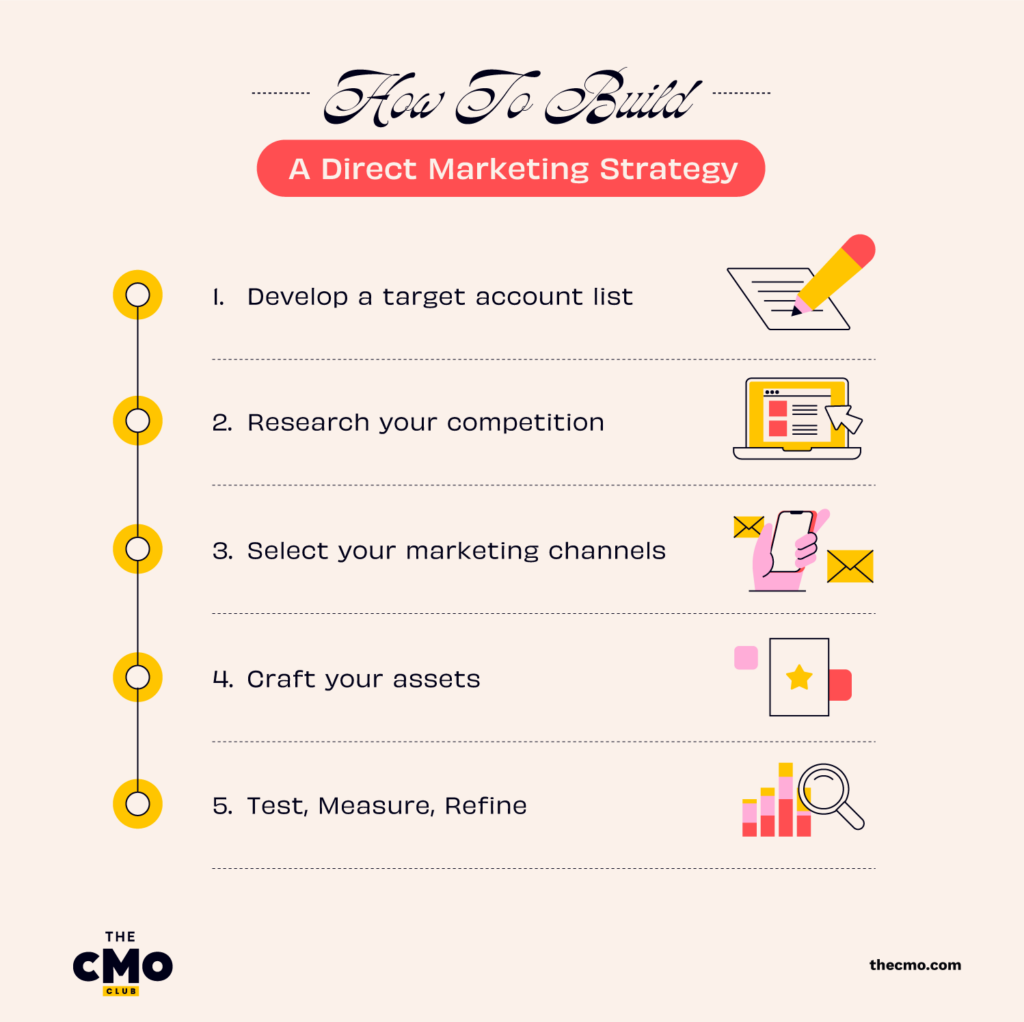It's common knowledge that businesses are always looking for innovative ways to connect with their audience. What's lesser known, is exactly how they do it. According to a 2023 study by HubSpot, 73% of Chief Marketing Officers (CMOs) feel that direct marketing is crucial for effective campaign implementation—but what is a direct marketing strategy, and how do you execute one properly?
In this article, I’ll share everything I know about the power of direct marketing in driving sales, brand awareness, and loyal customer relationships. Once you’ve got my handy how-to guide, I’ll cap things off with actionable tips to elevate your strategy and achieve big results.
What Is A Direct Marketing Strategy?
Different from a digital marketing strategy, a direct marketing strategy is a targeted approach aimed at reaching potential customers directly. It’s like when you receive a personalized email from your favorite brand with a discount tailored just for you! That's direct marketing in action—a strategic method to engage customers on a personal level, driving conversions and building loyalty.
How To Build A Direct Marketing Strategy

Building a direct marketing strategy requires a systematic approach to make sure you get the most bang for your buck. Let's break down five key steps:
1. Develop a target account list
Start by identifying potential customers who are most likely to be interested in your product or service. Consider demographics like age, gender, location, income level, behavioral data, and past purchasing history. Take advantage of your marketing CRM software to organize and manage your list.
Best Practice: Use a SQL vs MQL scoring system to prioritize leads based on their likelihood to convert. For example, assign higher scores to leads who have interacted with your brand multiple times or have previously made a purchase.
2. Research your competition
Study your competitors' strategies to understand their strengths and weaknesses. Analyze their messaging, offers, and marketing channels to identify opportunities to stand out. Use competitor analysis tools and conduct thorough market research to stay ahead of the curve.
Best Practice: Focus on what sets your brand apart and capitalize on your unique value proposition. Differentiate your offering by highlighting features, benefits, or values that resonate with your target audience.
3. Select your marketing channels
Choose the best marketing channels to reach your target audience. Consider factors like audience preferences, communication habits, and budget constraints. Popular direct marketing channels include:
- SMS
- Direct mail
- Social media
- Personalized websites
Best Practice: Use your marketing software to adopt a multichannel approach that maximizes reach and engagement. Tailor your messaging and content for each channel to keep consistency and relevance across all touchpoints.
4. Develop an offer and craft assets
Create unique offers and personalized content to capture customer attention and motivate action. Tailor your messaging to address their pain points, desires, and motivations. Pretty graphics, videos, and landing pages will also make your campaign stand out across social media platforms and online advertisements.
Best Practice: Focus on your value proposition and clearly communicate the benefits to your audience. Use persuasive language (ie. saying ‘you will’ instead of ‘you can’) to prompt immediate action.
5. Test, measure, and refine
Once you’re done, you’re never really done. You have to continuously analyze the campaign’s performance to optimize your strategy. Use A/B testing to compare different variables such as subject lines, visuals, and call-to-action (CTA) buttons. Use tools to track metrics such as open rates, click-through rates, and conversion rates.
Best Practice: Establish clear objectives and key performance indicators (KPIs) to measure the success of your campaigns. Regularly review data and adjust your strategy accordingly to improve results over time.
Types Of Direct Marketing (+ Examples)
There’s so many forms of direct marketing to talk about, but I chose the top five most common initiatives. Let’s look at how we can cut out the middleman and get straight to the consumer, with some examples of direct marketing.
Direct mail
A direct mail marketing strategy entails sending promotional materials such as postcards, mailers, or catalogs, directly to a recipient's physical mailbox. This may seem labor-intensive and time-consuming at first glance, but the right tools–which I’ll get into shortly–can really help you out.
For example: A local gym might send out postcards to households in its vicinity offering a discounted membership for new sign-ups or a free trial session.
Email marketing
A targeted email marketing strategy involves sending commercial messages to a specific audience via email. It’s a highly effective and cost-efficient way for businesses to communicate with their audience, nurture leads, and drive conversions.
For example: An online retailer might send out a newsletter to its subscribers featuring new product arrivals, exclusive discounts, and links to relevant blog posts or videos. Learn how to implement marketing automation to make nurturing leads through email even easier.
SMS marketing
SMS marketing, or short message service marketing, is vastly different from telemarketing. This is when you send texts to a targeted audience's mobile devices with promotional offers, alerts, or updates.
For example: A mobile service provider might send out a text message to its subscribers informing them about a limited-time offer on a new data plan or upgrades available for their current plan.
Direct-response marketing
Direct-response marketing is designed to prompt an immediate response or action from the recipient, usually with a specific call to action. This could include clicking a link, making a purchase, or filling out a form.
For example: A television infomercial may tell viewers to call a toll-free number or visit a website to place an order for a product within a specified timeframe.
Door-to-door marketing
It speaks for itself, but door-to-door marketing is when sales representatives or marketers physically visit residences or businesses to promote products or services. This one actually is labor-intensive and time-consuming, but you get that personal connection.
For example: A local utility company sending representatives door-to-door with marketing materials to promote energy-saving programs or package upgrades.
Telemarketing
Telemarketing is direct selling via phone call to promote products or services. You can engage prospects in real-time conversations to pitch offerings and try cross selling various products. In recent years, this direct marketing strategy has become less popular with Caller ID and the rise in scam phone calls.
For example: A telecommunications provider calling existing customers to upsell them on premium pricing packages or new features.
Benefits Of A Direct Marketing Strategy
There are several benefits of employing a direct marketing strategy, including:
- Cost-effective: Direct marketing allows for precise targeting, reducing wasted resources and maximizing return on investment.
- Personal touch: By addressing customers individually, direct marketing creates a personalized message, forging stronger relationships.
- Measurable: With analytics tools, you can track campaign performance in real-time, allowing for quick adjustments to optimize results.
- Accurate customer data: Direct marketing provides valuable insights into customer preferences and behavior, enabling better targeting and customization.
Challenges Of A Direct Marketing Strategy
Of course, there are always challenges to overcome before you can see benefits. These include:
- High initial costs: Building a direct marketing campaign may require significant upfront investment in research, data acquisition, and creative development.
- Lower reach: Direct marketing strategies may have a narrower reach compared to some other digital marketing approaches like PPC advertising.
- Targeting accuracy: Precision targeting relies heavily on accurate data, posing challenges in data collection and privacy compliance.
Tools
I mentioned earlier that with the right tools, you can streamline your direct marketing efforts to ensure they’re as efficient and effective as possible. Here are my recommendations:
Marketing software: Marketing software provides solutions for planning, executing, and analyzing marketing campaigns across various channels. Features can include customer segmentation, campaign automation, analytics, and more.
Email marketing software: Email marketing software helps with the creation, delivery, and tracking of email campaigns. Features can include customizable templates, automated workflows, A/B testing, and analytics.
SMS marketing software: SMS marketing software allows businesses to send promotional messages, alerts, and updates directly to customers' mobile phones via text message. They can offer features like contact management, scheduling, personalized messaging, and analytics.
Direct mail marketing software: Direct mail marketing software helps businesses to design, execute, and track offline marketing campaigns, such as postcards, flyers, and catalogs, sent through postal mail. These tools often include features like mailing list management, template design, postage optimization, and campaign tracking.
Tips And Best Practices
Once you have the right tools, you’ll also want to follow strategy best practices to maximize results. Here are some tips to keep in mind:
- Use segmentation: Segment your audience to send tailored messages and offers, enhancing relevance and increasing conversion rates. By categorizing customers based on demographics, behaviors, or preferences, you can deliver targeted content that speaks to their specific interests and needs, increasing engagement and driving results.
- Personalize as much as possible: Personalization is key to creating meaningful interactions with your customer base. Utilize data insights to customize notifications, product recommendations, and special offers, making each communication feel personalized and relevant. Psst… here are some ways to personalize email marketing.
- Stay consistent: Consistency in branding across all channels is key to building trust and credibility with your audience. From messaging and visuals to tone and values, maintaining a cohesive brand identity across all marketing efforts reinforces your brand's authenticity.
- Use a multichannel approach: If you use a multichannel marketing strategy you’ll reach your audience wherever they are, not just through the company website! By diversifying your touchpoints, you can maximize visibility, engagement, and ultimately, conversions.
Join For More Direct Marketing Insights
Direct marketing is super beneficial for businesses seeking to stand out from the competition. By understanding the fundamentals and implementing best practices, you can unlock the full potential of direct marketing to drive sales and continued long-term customer loyalty.
Remember to subscribe to The CMO newsletter to opt in to exclusive insights and updates on the latest marketing trends.


